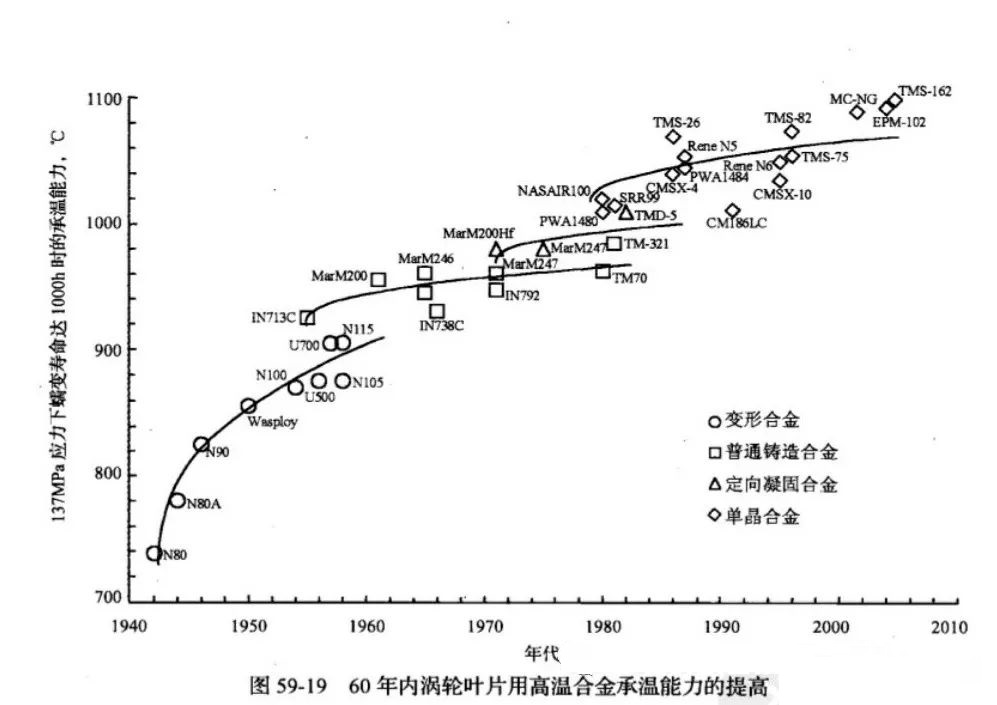Turbine working blades rotate at high speed in high temperature gas, not only bear its own centrifugal force, aerodynamic force, thermal stress and vibration load, but also be corroded under the action of gas. Therefore, it is the most severe working conditions in the engine parts. Improve the gas temperature in front of the turbine is the key condition for the development of the engine, and turbine blades (especially 1 level turbine blades) of the high temperature performance of the gas temperature in front of the turbine plays a decisive role in the improvement of the gas temperature in the 20th century, 50 ~ 60 years, the engine’s gas temperature of 800 ~ 1050 ℃, the turbine blade material selection of the use of low-temperature deformation of nickel-based high-temperature alloys, its temperature capacity of 700 ~ 900 ℃; the 20th century, 70 years, the engine’s gas temperature of 700 ~ 900 ℃; the engine’s gas temperature of 700 ~ 900 ℃. 900 ℃; around the 1970s, the use of the temperature is higher than the same composition of the deformation of high-temperature alloys about 30 ℃ nickel-based casting high-temperature alloys, the use of its temperature up to 950 ℃ or so; to the 1980s, the elimination of transverse grain boundaries of the directional solidification of high-temperature alloys have been widely used, and its use of the temperature of the same composition of the same composition of iso-axial crystalline casting alloys is higher than the temperature of 20 ~ 30 ℃, blade temperature-bearing capacity to reach 980 ℃ or so; 1990s to the beginning of the 21st century, the elimination of all the grain boundaries of nickel-based single crystal high temperature alloy, due to its use of the temperature than the directional solidification of the column crystal alloy has been further greatly improved, the highest use of the temperature up to 1050 ~ 1,100 ℃, and thus has been widely used.
1. Deformation of high-temperature alloys due to nickel-based deformation of high-temperature alloys have high mechanical properties, such as high fatigue, creep, oxidation and thermal corrosion resistance, become the best candidate for the early production of gas turbine blades. Therefore, the initial development of the turbine blade material of the aero-engine is commonly used deformed high-temperature alloys. Nickel-based high-temperature alloys are developed from nickel-chromium resistance alloys (Cr20, Ni80). 1939, the British Mond Nickel Company (now known as the International Nickel Corporation) in this alloy on the basis of the development of a small amount of C and Ti nickel-based alloy Nimonic 75, used as a short-term use of the turbine blade material. Soon, on the basis of Nimonic 75, add Al and increase Ti content, developed a more superior performance of NImonic 80 alloy, the use of its temperature is 50 ℃ higher than Nimonic 75. 1942, Nimonic 80 was successfully used as a turbojet engine blades, is the earliest application of γ-reinforced turbine blade materials. Since then, the company has added boron, zirconium, cobalt, molybdenum and other alloying elements to the alloy, and successively developed Nimonic 80A, Nimonic 90, Nimonic 100, Nimonic 105 and Nimonic 115 alloys for making turbine blades.
In the late Second World War, the United States to meet the needs of the military industry developed into a deformed nickel-based alloy used to manufacture turbine blades Inconel X-750. Inconel X-750 alloy added Al, Ti and Nb strengthening elements, 980 ℃ has good strength, good oxidation and corrosion resistance, widely used. early 1950s, Pratt & Whitney Aircraft Company, Inc. In the early 1950s, Pratt & Whitney Aircraft Company, General Electric Company and Special Metals Company developed Waspaloy, M-252 and Udimet 500 and other important alloys for the manufacture of gas turbine blades. On the basis of Ni-Cr-Al-Ti alloy, the Soviet Union in 1954 developed a successful turbine blade with deformed nickel-based alloy ЭN617.
Post time: Aug-05-2023











